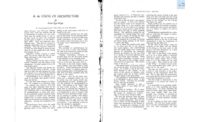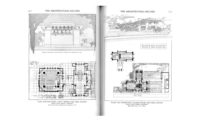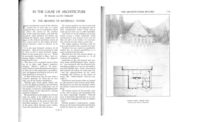That individuality in a building was possible for each homemaker, or desirable, seemed at that time to rise to the dignity of an idea. Even cultured men and women care so little for the spiritual integrity of their environment; except in rare cases they are not touched, they simply do not care for the matter so long as their dwellings are fashionable or as good as those of their neighbors and keep them dry and warm. A structure has no more meaning to them aesthetically than has the stable to the horse. And this came to me in the early years as a definite discouragement. There are exceptions, and I found them chiefly among American men of business with unspoiled instincts and untainted ideals. A man of this type usually has the faculty of judging for himself. He has rather liked the "idea" and much of the encouragement this work receives comes straight from him because the "common sense" of the thing appeals to him. While the "cultured" are still content with their small chateaux, colonial wedding cakes, English affectations, or French millinery, he prefers a poor thing but his own. He errs on the side of character, at least, and when the test of time has tried his country's development architecturally, he will have contributed his quota, small enough in the final outcome though it be; he will be regarded as a true conservator.
In the hope that some day America may live her own life in her own buildings, in her own way, that is, that we may make the best of what we have for what it honestly is or may become, I have endeavored in this work to establish a harmonious relationship between ground plan and elevation of these buildings, considering the one as a solution and the other in expression of the conditions of a problem of which the whole is a project. I have tried to establish an organic integrity to begin with, forming the basis for the subsequent working out of a significant grammatical expression and making the whole, as nearly as I could, consistent.
What quality of style the buildings may possess is due to the artistry with which the conventionalization as a solution and an artistic expression of a specific problem within these limitations has been handled. The types are largely a matter of personal taste and may have much or little to do with the American architecture for which we hope.
From the beginning of my practice, the question uppermost in my mind has been not "what style?" but "what is style?" and it is my belief that the chief value of the work illustrated here will be found in the fact that if in the face of our present-day conditions any given type may be created independently and imbued with the quality of style, then a truly noble architecture is a definite possibility, so soon as Americans really demand it of the architects of the rising generation.
I do not believe we will ever again have the uniformity of type which has characterized the so-called great "styles." Conditions have changed; our ideal is Democracy, the highest possible expression of the individual as a unit not inconsistent with a harmonious whole. The average of human intelligence rises steadily, and as the individual unit grows more and more to be trusted we will have an architecture with rather variety in unity than has ever arisen before, but the forms must be born out of our changed conditions, they must be true forms, otherwise the best tradition has to offer is only an inglorious masquerade, devoid of vital significance or true spiritual value.
The trials of the early days were many and at this distance picturesque. Workmen seldom like to think, especially if there is financial risk entailed; at your peril do you disturb their established processes mental or technical. To do anything in an unusual, even if in a better and simpler way, is to complicate the situation at once. Simple things at that time in any industrial field were nowhere at hand. A piece of wood without a molding was an anomaly; a plain wooden slat instead of a turned baluster a joke, the omission of the merchantable "grille" a crime; plain fabrics for hangings or floor covering were nowhere to be found in stock.
To become the recognized enemy of the established industrial order was no light matter, for soon whenever a set of my drawings was presented to a Chicago mill-man for figures he would willingly enough unroll it, read the architects's name, shake his head, and return it with the remark that he was " not hunting for trouble"; sagacious owners and general contractors tried cutting out the name, but in vain, his perspicacity was ratlike, he had come to know "the look of the thing." So, in addition to the special preparation in any case necessary for every little matter of construction and finishing, special detail drawings were necessary merely to allow the things to be left off or not done and not only studied designs for every part had to be made but quantity surveys and schedules of millwork furnished the contractors beside. This, in a year or two, brought the architect face to face with the fact that the fee for his service "established" by the American Institute of Architects was intended for something stock and shop, for it would not even pay for the bare drawings necessary for conscientious work.
The relation of the architect to the economic and industrial movement of his time, in any fine-art sense, is still an affair so sadly out of joint that no one may easily reconcile it. All agree that something has gone wrong and except the architect be a plain factory magnate, who has reduced his art to a philosophy of old clothes and sells misfit or made over-ready-to-wear garments with commercial aplomb and social distinction, he cannot succeed on the present basis established by common practice. So, in addition to a situation already completed for them, a necessarily increased fee stared in the face the clients who dared. But some did dare, as the illustrations prove.
The struggle then was and still is to make "good architecture," "good business." It is perhaps significant that in the beginning it was very difficult to secure a building loan on any terms upon one of these houses, now it is easy to secure a better loan than ordinary; but how far success has attended this ambition the owners of these buildings alone can testify. Their trials have been many, but each, I think, feels that he has as much house for his money as any of his neighbors, with something in the home intrinsically valuable besides, which will not be out of fashion in one lifetime and which contributes steadily to his dignity and his pleasure as an individual. It would not be useful to dwell further upon difficulties encountered, for it is the common story of simple progression everywhere in any field; I merely wish to trace here the "motif" behind the types. A study of the illustrations will show that the buildings presented fall readily into three groups having a family resemblance; the low-pitched hip roofs, heaped together in pyramidal fashion or presenting quiet, unbroken skylines; the low roofs with simple pediments countering on long ridges; and those topped with a simple slab. Of the first type, the Winslow, Henderson, Willits, Thomas, Heurtley, Heath, Cheney, Martin, Little, Gridley, Millard, Tomek, Coonley, and Westcott houses, the Hillside Home School and the Pettit Memorial Chapel are typical. Of the second type, the Bradley, Hickox, Davenport and Dana houses are typical. Of the third, atelier for Richard Bock, Unity Church,3 the concrete house of The Ladies' Home journal, and other designs in process of execution. The Larkin Building is a simple, dignified utterance of a plain, utilitarian type, with sheer brick walls and simple stone copings. The studio is merely an early experiment in "articulation."
Photographs do not adequately present these subjects. A building has a presence, as has a person, that defies the photographer, and the color so necessary to the complete expression of the form is necessarily lacking; but it will be noticed that all the structures stand upon their foundations to the eye as well as physically. There is good, substantial preparation at the ground for all the buildings and it is the first grammatical expression of all the types. This preparation, or water table, is to these buildings, what the stylobate was to the ancient Greek temple. To gain it, it was necessary to reverse the established practice of setting the supports of the building to the outside of the wall and to set them to the inside, so as to leave the necessary support for the outer base. This was natural enough and good enough construction but many an owner was disturbed by private information from the practical contractor to the effect that he would have his whole house in the cellar if he submitted to it. This was at the time a marked innovation though the most natural thing in the world and to me, to this day, indispensable.
With this innovation established, one horizontal stripe of raw material, the foundation wall above ground, was eliminated and the complete grammar of type one made possible. A simple, unbroken wall surface from foot to level of second story sill was thus secured, a change of material occurring at that point to form the simple frieze that characterizes the earlier buildings. Even this was frequently omitted, as in the Francis apartments4 and many other buildings, and the wall was let alone from base to cornice or eaves. "Dress reform houses" they were called, I remember, by the charitably disposed. What others called them will hardly bear repetition.
As the wall surfaces were thus simplified and emphasized the matter of fenestration became exceedingly difficult and more than ever important, and often I used to gloat over the beautiful buildings I could build if only it were unnecessary to cut holes in them: but the holes were managed at first frankly as in the Winslow house and later as elementary constituents of the structure grouped in rhythmical fashion, so that all the light and air and prospect the most rabid client could wish would not be too much from in artistic standpoint; and of this achievement I am proud. The groups are managed, too, whenever required. so that overhanging eaves do not shade them, although the walls are still protected from the weather. Soon the poetry-crushing characteristics of the guillotine window, which was then firmly rooted, became apparent, and singlehanded I waged a determined battle for casements swinging out, although it was necessary to have special hardware made for them as there was none to be had this side of England. Clients would come ready to accept any innovation but "those swinging windows," and when told that they were in the nature of the proposition and that they must take them or leave the rest, they frequently employed "the other fellow" to give them something "near," with the "practical" windows dear to their hearts.
With the grammar so far established, came an expression pure and simple, even classic in atmosphere, using that much-abused word in its best sense; implying, that is, a certain sweet reasonableness of form and outline naturally dignified.







